Summary
Hey there! Let's grab a virtual coffee and chat about something that makes many founders sweat—the financials slide in your pitch deck.
Key Takeaways:
Your financials slide shows investors how your brilliant ideas will make money.
Strike the sweet spot between too much detail and too little information.
Back up your future predictions with solid past performance data.
Think of your pitch deck as a movie trailer for your startup, with the financials slide being that dramatic moment leaving everyone wanting more. Here at spectup, we've reviewed enough pitch decks to fill a library, and trust me—a sharp financials slide often separates the funded from the frustrated.
Your financials slide isn't just about tossing numbers on a screen. It's your chance to tell a money story that makes investors lean forward in their chairs. Remember when Netflix showed how their DVD-by-mail service would make cash? That's the kind of clear, exciting financial tale you want to spin.
You're not just showing spreadsheets—you're painting a picture of growth that investors can believe in. It's like handing them a treasure map where X marks the spot, but instead of hoping for buried gold, you're backing it up with real data and smart projections.
What is the Pitch Deck Financials Slide?
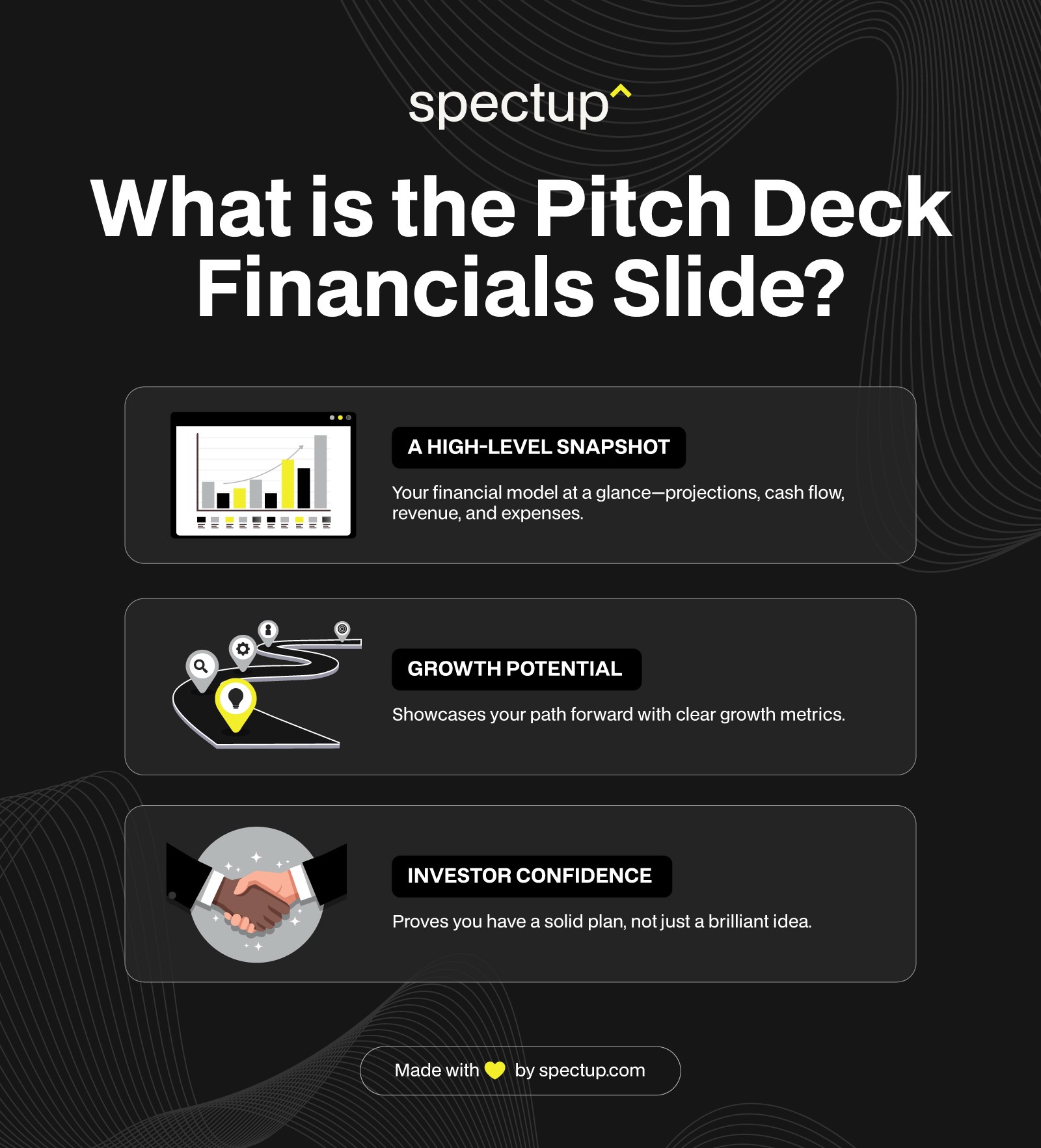
Let’s talk about the Pitch Deck Financials Slide—a vital part of any pitch deck where your business idea meets numbers. This isn’t just a dull spreadsheet; it’s the heartbeat of your deck that proves you’ve got more than a vision—you have a plan. Done right, it convinces investors that your idea is not just possible but profitable.
Definition
The Pitch Deck Financials Slide is a high-level snapshot of your financial model—your financial projections, cash flow, and key elements like revenue projections and operating expenses. It’s designed to show growth potential and a clear path forward, making it crucial in Series-A rounds and beyond. Essentially, it’s a story in numbers that tells investors where you stand financially and where you’re headed.
Role in the Pitch Deck
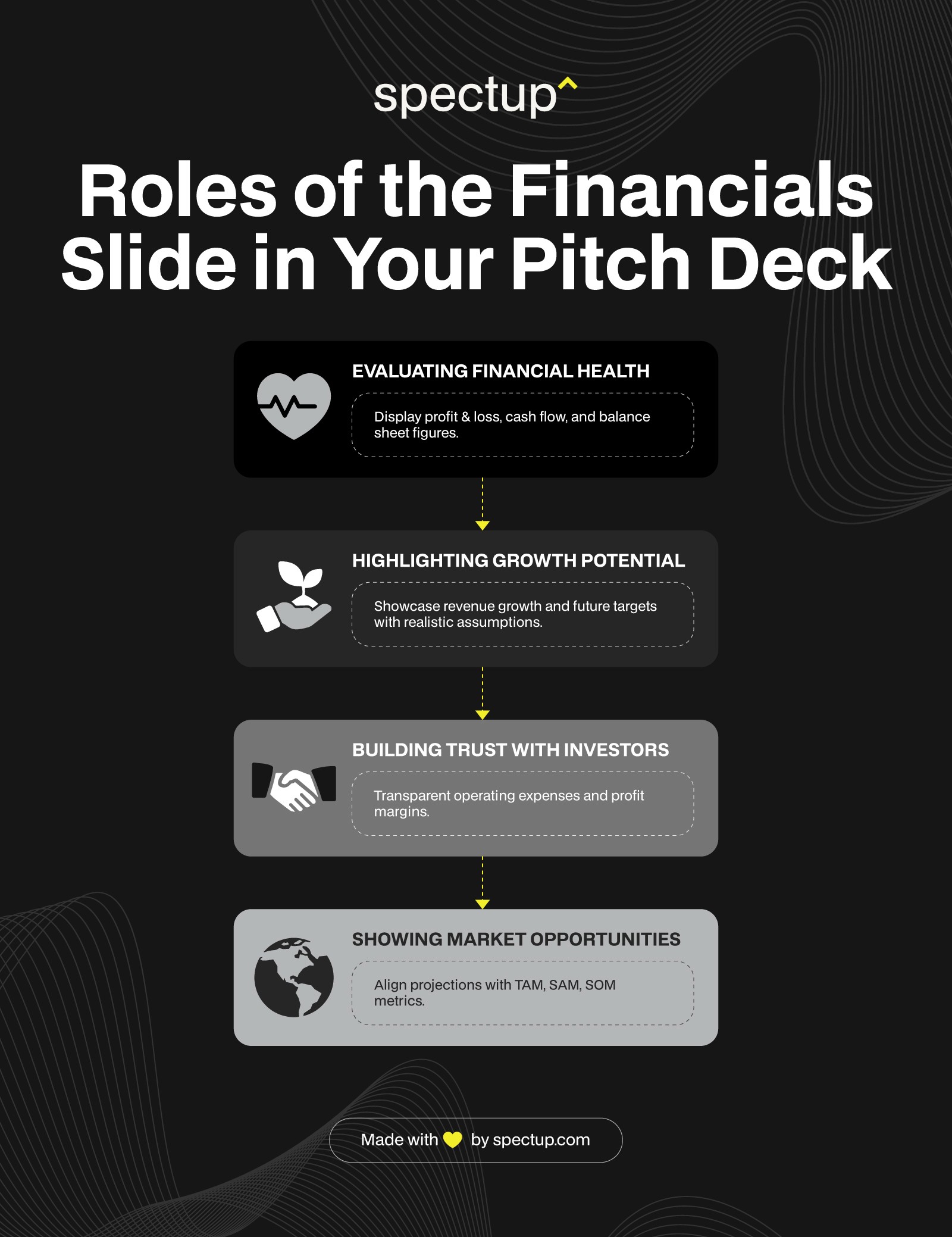
Here’s why this slide is crucial:
Evaluating Financial Health
This slide acts as your financial report card. It’s where you display profit and loss statements, cash flow statements, and balance sheet figures. Highlighting gross margin, customer acquisition cost, and profit margins allows investors to assess if your business model can grow sustainably.
Highlighting Growth Potential
Investors want to see how far your startup can go. The financial projections slide should showcase revenue growth and future targets backed by realistic key assumptions and industry benchmarks. In SaaS, for instance, metrics like lifetime value and customer acquisition cost are key. For accurate projections, tools like Rocket Pro Forma can be helpful.
Building Trust with Investors
Numbers build trust. By transparently showing operating expenses, monthly burn rate, and profit margins, you demonstrate you understand your business’s needs and limitations. This organized transparency reassures investors that your financial plan is based on thoughtful, realistic data.
Showing Market Opportunities
The financial slide pitch deck should show how your projections line up with the total addressable market. Using TAM, SAM, and SOM metrics can illustrate how much of the market you aim to capture, proving there’s room to grow.
Financials Slide vs. Detailed Financial Model
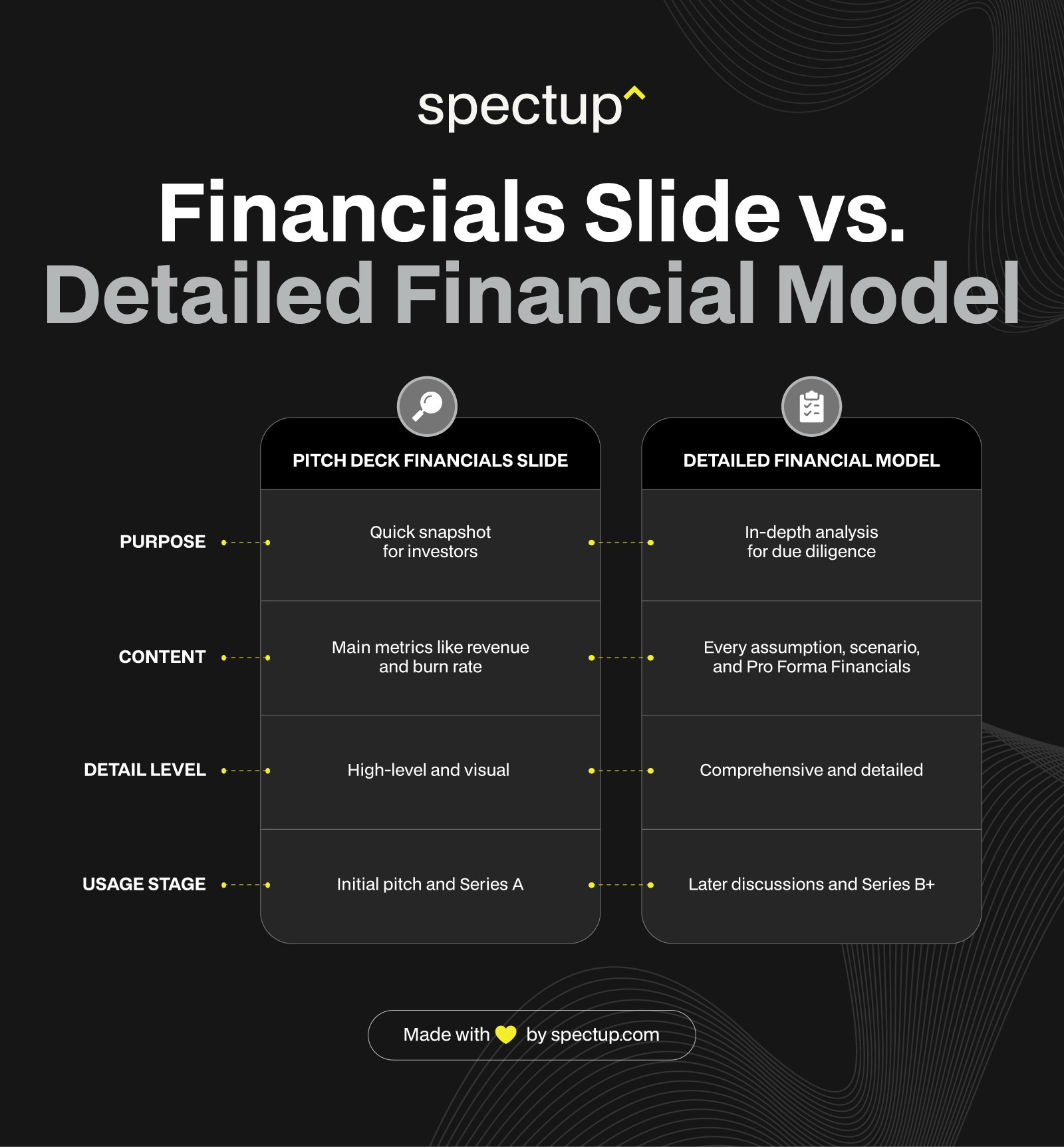
Remember, there’s a difference between this slide and your financial model:
Pitch Deck Financials Slide: This is a quick, visually clear snapshot. Focus on main metrics like revenue, burn rate, and profit margins. Investors just need the highlights here.
Detailed Financial Model: This in-depth document is for later discussions. It dives into every assumption, scenario, and Pro Forma Financials that investors want during due diligence.
Your financial slide isn’t just numbers; it’s a blend of strategy and confidence that convinces investors to take the leap. Each stage of funding, from pre-seed to Series C, has different expectations for financial slides, and tailoring your pitch deck financial slide accordingly can make a real impact.
A well-constructed financial projections slide tells investors a story of growth and opportunity, with real numbers to back it up. At spectup, we help startups create pitch decks that resonate with investors by transforming financials slide into a powerful narrative. So, when crafting your pitch deck financials, make it count. Show them not just the numbers but the path forward.
Key Elements of a Strong Financials Slide
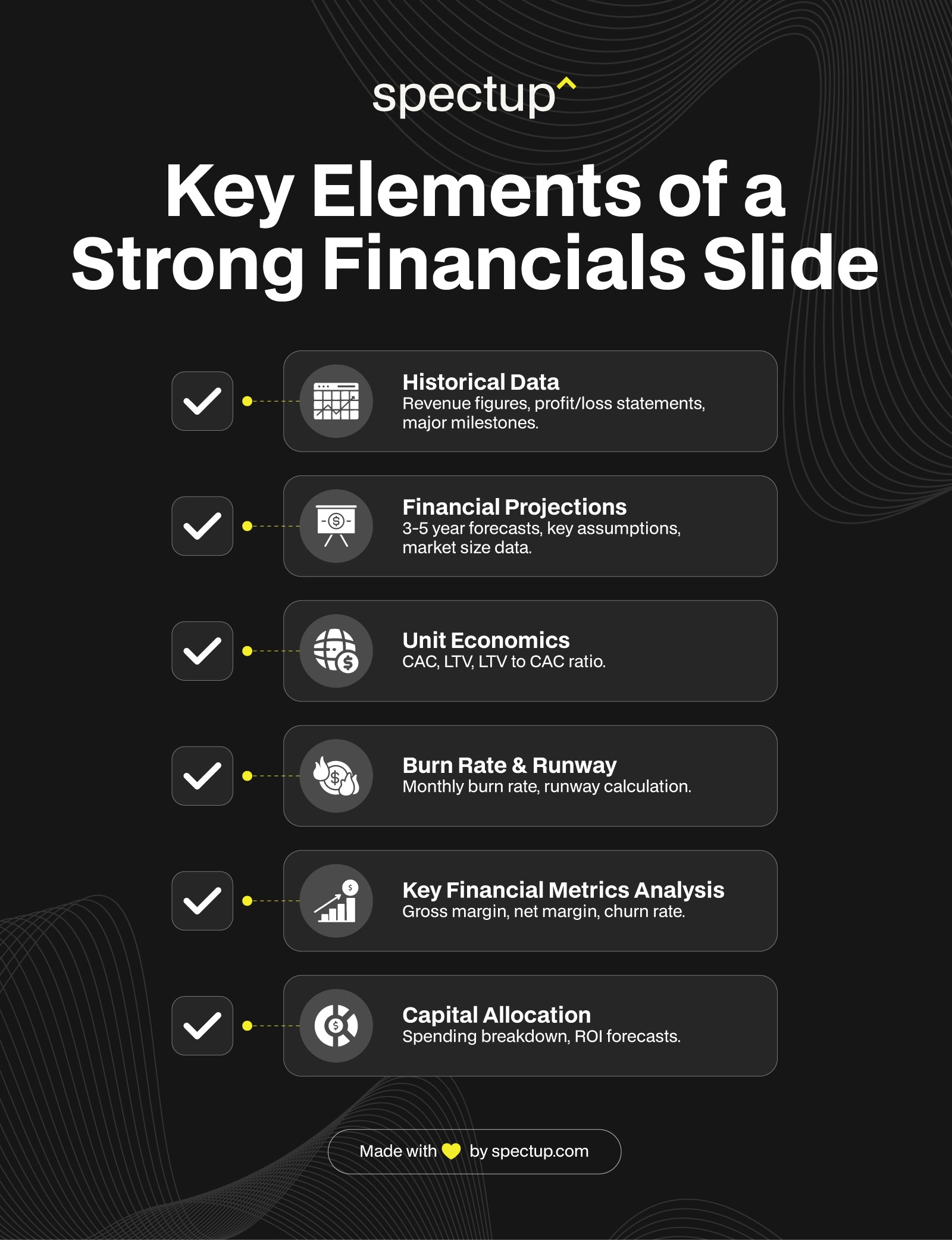
Ever tried piecing together a puzzle without the picture on the box? That's what creating a compelling financial slide for your pitch deck can feel like. Each piece—revenues, expenses, and key metrics—needs to fit just right to give potential investors a clear view of your startup's financial health and growth potential.
To make your financials slide stand out, lay out your financial data like revenue projections and operating expenses in a way that tells a story. It’s not just numbers; it’s how those numbers capture your journey and where you’re headed. When potential investors get the big picture at a glance, you’re already halfway to securing that “yes.”
Historical Data
Importance
Historical data is your track record—proof of what your startup has achieved so far. Sharing these numbers builds credibility and provides a foundation for your future projections. Investors like knowing you’re already making strides, which can make them more confident about your financial projections.
What to Include
Revenue: Show past revenue figures so investors can see your growth trajectory.
Profit/Loss: A profit and loss statement reveals when you made or lost money, helping investors understand the ups and downs of your financial health.
Major Financial Milestones: Did you reach break-even, secure big contracts, or achieve high revenue growth? Highlight these successes in your financial slide pitch deck.
It’s also worth mentioning details from your balance sheet—assets, debts, and shareholder equity—for a full financial picture.
Financial Projections
Why They Matter
Financial projections are the “where we’re going” part of the story. They give investors an idea of whether your business can generate significant returns and provide a solid look at your financial viability.
What to Include
3-5 Year Forecasts: These include revenue, costs, profit margins, and other key metrics. Investors want to see stable, predictable growth.
Assumptions Behind Projections: Explain your underlying assumptions—like anticipated market demand or product expansion—so investors understand the rationale behind your numbers.
Market Size Information: Add some context with market size data to support your business’s potential for growth.
You can also include strategies to weather economic uncertainty, showing that your business model is adaptable and prepared for various scenarios.
Unit Economics
Importance
Unit economics is the “how sustainable are we?” question. By breaking down customer acquisition cost (CAC), customer lifetime value (LTV), and other metrics, you can show investors if you’re bringing in more than you’re spending per customer.
What to Include
Customer Acquisition Cost (CAC): Show how much it costs to win one customer, giving a window into your marketing budget and spending efficiency.
Lifetime Value of a Customer (LTV): This figure tells investors how much revenue each customer generates over time. Knowing this value is critical to understanding your profit margins.
LTV to CAC Ratio: This ratio shows if your revenue model is profitable in the long run. A strong ratio suggests scalable growth potential, which is exactly what investors want to see.
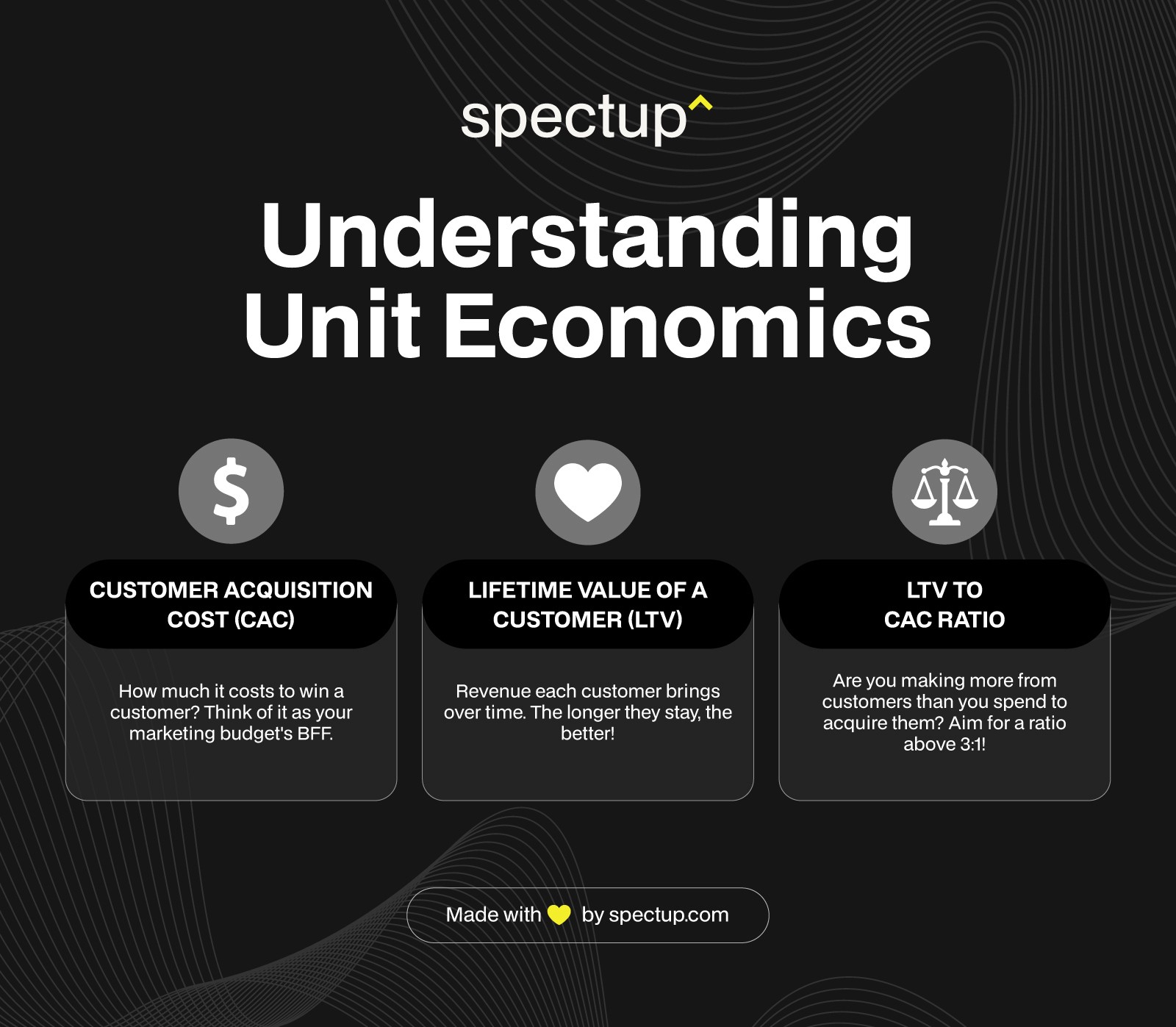
Burn Rate & Runway
Importance
Burn rate is your spending pace, and runway tells you how long you’ve got until you need more cash. These metrics are essential for understanding your startup’s financial viability and sustainability.
What to Include
Monthly Burn Rate: Lay out how much you’re spending each month so investors know what it takes to keep the lights on.
Runway: Calculate how many months you have left before you’ll need to raise more money. A clear runway shows investors you have a plan for when and how you’ll seek funding.
Additionally, adopting strategies like the Lean Startup approach can help your team manage costs effectively, especially with so many people working remotely nowadays.
Key Financial Metrics Analysis
Importance
Tracking key financial metrics helps investors gauge your company’s financial health and operational efficiency. Metrics like gross margin and net margin show if your business is on solid ground.
What to Include
Gross Margin: This tells investors how much of your total revenue is left after covering the Cost of Goods Sold (COGS). A higher gross margin means more flexibility to cover operating expenses.
Net Margin: After all expenses, this shows the percentage of profit left. High net margins are a sign of strong financial health.
Churn Rate: How many customers are you losing over time? Monitoring churn helps you understand customer loyalty and retention.
It’s also a good idea to compare these numbers with industry benchmarks to show how you stack up against competitors.
Capital Allocation
Importance
A clear capital allocation plan shows investors that you’ve thought through how you’ll use their investment wisely. It’s not just about raising funds; it’s about using them strategically.
What to Include
Spending Breakdown: Detail your spending priorities, like product development, marketing, or hiring, and show how these align with your strategic planning.
ROI Forecasts: Share your projected returns on investments in each area. Clear ROI targets impress investors and demonstrate growth potential.
Every part of your pitch deck financials slide should be geared toward convincing investors that your startup is not only viable but also primed for growth. Keep it clear, simple, and trustworthy, aiming to tell a story with the numbers that’s easy to follow yet impactful. The right mix of data and narrative makes a killer financial slide that builds confidence and leaves investors eager to hear more.
Common Mistakes to Avoid in Your Pitch Deck Financials Slide
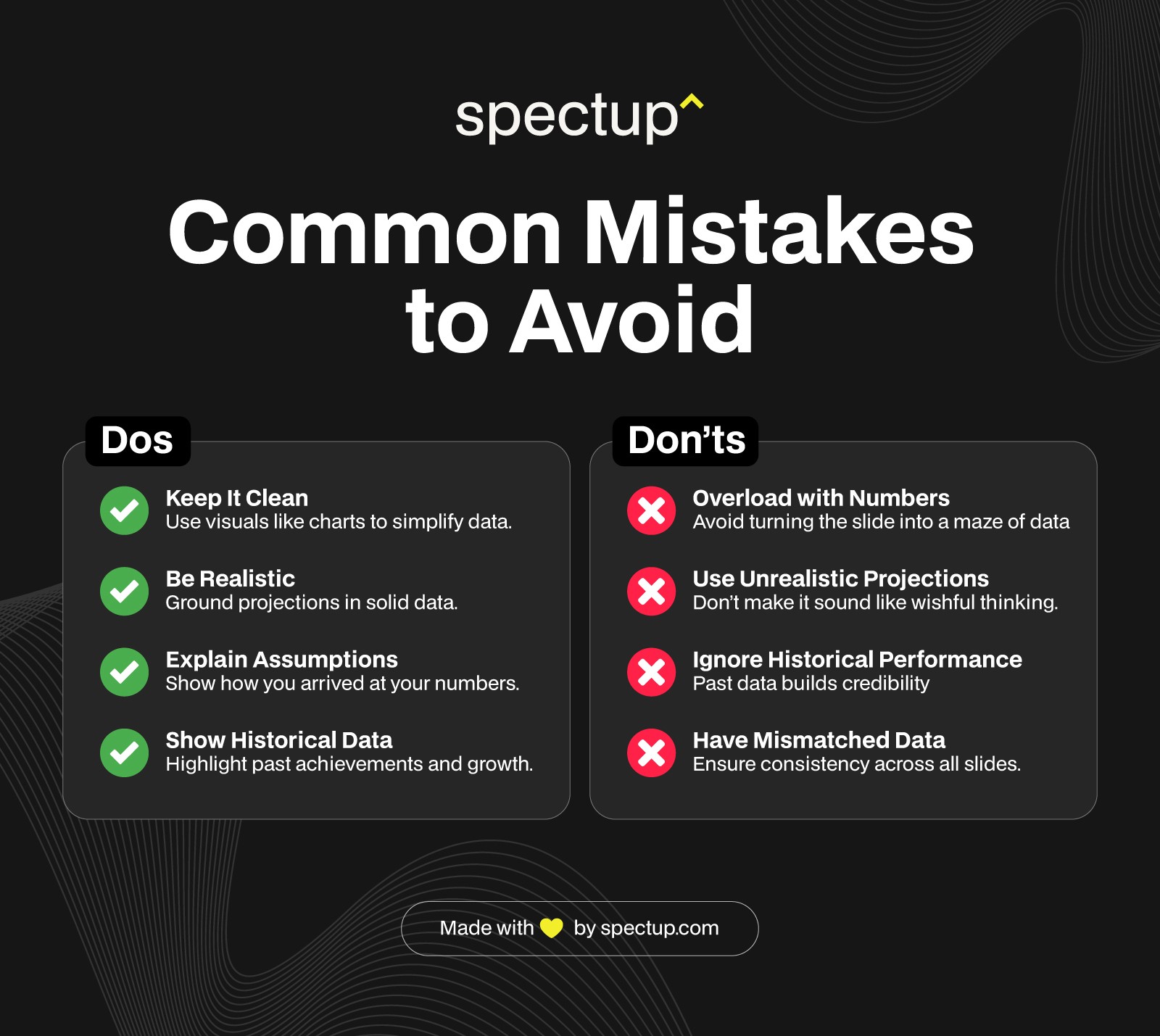
Even the savviest entrepreneurs can stumble when crafting their pitch deck financials slide. Avoiding the usual traps here is essential—not just for looking sharp but for building trust with potential investors. A misstep in this part of your pitch deck could raise eyebrows and even cast doubts over your entire venture.
Let’s break down the common slip-ups and how to steer clear of them.
Simplifying the Financials Slide
The Mistake: Overloading the slide with too much information, turning it into a maze of numbers.
The Solution: Keep it clean and to the point. Aim for a simple, straightforward presentation that communicates the essentials. Use visuals like line charts and graphs to make your financial data easy on the eyes. A well-designed financial projection slide can turn complex data into a story investors will remember. In industries from renewable energy to e-commerce, we’ve seen firsthand how a well-organized slide can make financials compelling, not confusing.
Unrealistic Projections
The Mistake: Presenting overly optimistic financial projections can make your pitch sound like wishful thinking.
The Solution: Ambition’s great, but keep your projections grounded in reality. Start with solid key assumptions based on real data and market research. Investors would much rather see cautious projections you can exceed than lofty targets you can’t reach. Building projections that are cautiously optimistic yet realistic demonstrates that you’re more than a dreamer—you’re a savvy entrepreneur with a grounded business model.
Missing Important Assumptions
The Mistake: Throwing in projections without explaining how you arrived at them.
The Solution: Never leave investors guessing. Include a quick summary of the key assumptions behind your numbers. Showing how you arrived at your figures helps build trust and transparency. Make sure investors know if your projections are based on an increase in cash flow or anticipated growth in market size. Clarity here can make all the difference in building confidence.
Ignoring Historical Data
The Mistake: Focusing only on the future without mentioning past performance.
The Solution: Think of your past numbers as your startup’s credibility card. Show how your financial data has grown over time, including achievements or trends that highlight stability. Using clear visuals for this historical data reinforces that you’re not just talking big about the future—you’ve got a record to back it up.
Mismatched Data
The Mistake: Inconsistencies between your financial slides and the rest of your pitch deck.
The Solution: Double-check everything! Ensure all data points align with what’s in the rest of your deck and any outside sources you’ve referenced. If your cash flow statements don’t match your future plans or you’ve got conflicting revenue figures, investors will notice. Consistency across the board can strengthen your message and make your financial model look solid.
Generic Metrics Without Customization
The Mistake: Using cookie-cutter metrics that don’t really reflect your business.
The Solution: Customize metrics to match your sector. Don’t rely on generic financial measures if they don’t speak to your business model. If you’re in SaaS, for example, focus on customer acquisition costs and lifetime value rather than traditional retail metrics. Tailoring metrics to your industry and business model shows investors you know your landscape well.
Bad Design and Layout
The Problem: A messy slide distracts and can make you look unprofessional.
The Fix: Stick to a clean layout with consistent fonts and colors. If design isn’t your thing, use templates or get help from a designer to make sure your slides are polished. The goal is to keep the focus on the numbers, not a cluttered presentation.
Ignoring Possible Concerns
The Mistake: Hiding or glossing over obvious financial challenges, like a high burn rate.
The Solution: Don’t sweep issues under the rug. If you’ve got a high monthly burn rate, address it honestly, and share your plan for managing spending. Investors appreciate transparency. By tackling potential red flags head-on, you’ll show them you’re prepared to handle challenges, which builds confidence in your financial health.
In the end, creating an effective pitch deck financials slide is all about clarity, consistency, and a dash of finesse. Avoid these common pitfalls, and you’ll have a slide that not only stands out but also builds trust and shows investors you’re a pro worth betting on.
Design Tips for an Engaging Financials Slide
Ever sat through a presentation where the financials slide made numbers feel like ancient hieroglyphs? We’ve all been there—squinting at cluttered figures, trying to decipher what the numbers mean. But it doesn’t have to be that way. With a few design tweaks, you can make your financial slides come alive, turning cold numbers into a story that captures attention.
So, here are some straightforward tips to help your financials slide not just inform, but impress.
Use Clear Visuals
Swapping out dense numbers for visuals like graphs and line charts can make complex data a breeze to understand. Think of it as turning a textbook into a comic strip—same information, just more fun.
Tips:
Use bar graphs to show growth, like your startup’s revenue climbing over time.
Opt for line charts for trends—it’s like mapping the journey of your cash flow.
Pie charts are perfect for showing percentages—who doesn’t love a good slice of pie?

Make Financial Slides Easy to Read
Ever felt like you’re on a packed subway when reading a busy slide? If your slide’s overcrowded, you’re losing people.
Tips:
Pick a clean, readable font and stick with it throughout your pitch deck.
Add white space to give those numbers some breathing room.
Break up text with bullet points instead of long-winded paragraphs. Keep it punchy.
Consistent Branding in Pitch Decks
Ever noticed how certain brands, like Apple, have a unique look to their presentations? Consistency in branding isn’t just for aesthetics—it’s for memorability.
Tips for Keeping Branding Consistent in Pitch Decks:
Stick to a color scheme that aligns with your brand’s vibe—maybe it’s bold reds or calming blues.
Limit yourself to 2-3 colors to avoid a rainbow mess.
Place logos subtly. You want them there, but you don’t want them yelling at your audience.
Highlight Important Metrics
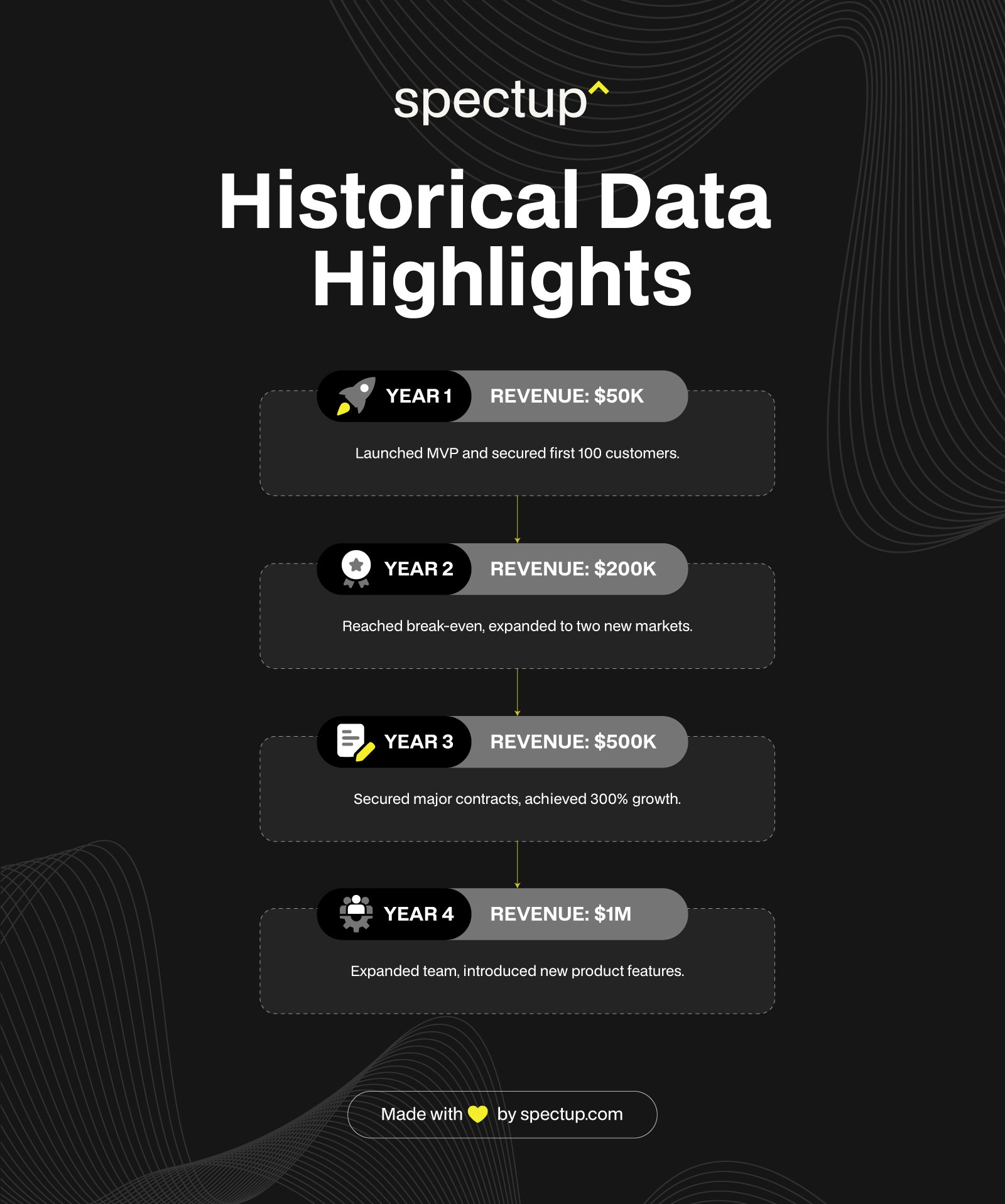
You want your audience to remember the highlights, not get bogged down in endless data.
Tips:
Use bold or contrasting colors to make crucial data points stand out.
Position top metrics front and center so they catch the eye.
Keep a Clear Flow in Financial Slides
A good story has a beginning, middle, and end. So should your financials slide. A logical flow keeps the audience engaged and helps them follow along effortlessly.
Tips:
Use arrows or color changes to guide viewers through your information.
Structure data in a way that builds up to your future projections.
Use Icons Wisely in Pitch Decks
Icons can add flair, but too many can turn your slide into a chaotic sticker book.
Tips:
Choose simple icons that enhance rather than distract from your message.
Keep icon styles consistent for a polished, cohesive look.
Keep Annotations Short
If you’re writing paragraphs on a slide, you might lose your audience faster than you think.
Tips:
Be brief and to the point with notes.
Use plain language that everyone can understand, not just financial pros.
Testing for Different Screens
Have you ever put together a slide that looked fantastic on your laptop, only for it to look fuzzy on a projector? That’s a risk with any pitch deck.
Tips:
Test on different screens to ensure everything looks sharp and legible.
Avoid color combinations that might be hard to read in various settings, like bright red on neon green.
spectup knows your financial slide design should not only be visually appealing but also impactful. By following these tips, you can make your numbers stand out and tell your story effectively. In a fast-paced world, every detail counts for a memorable presentation.
Conclusion
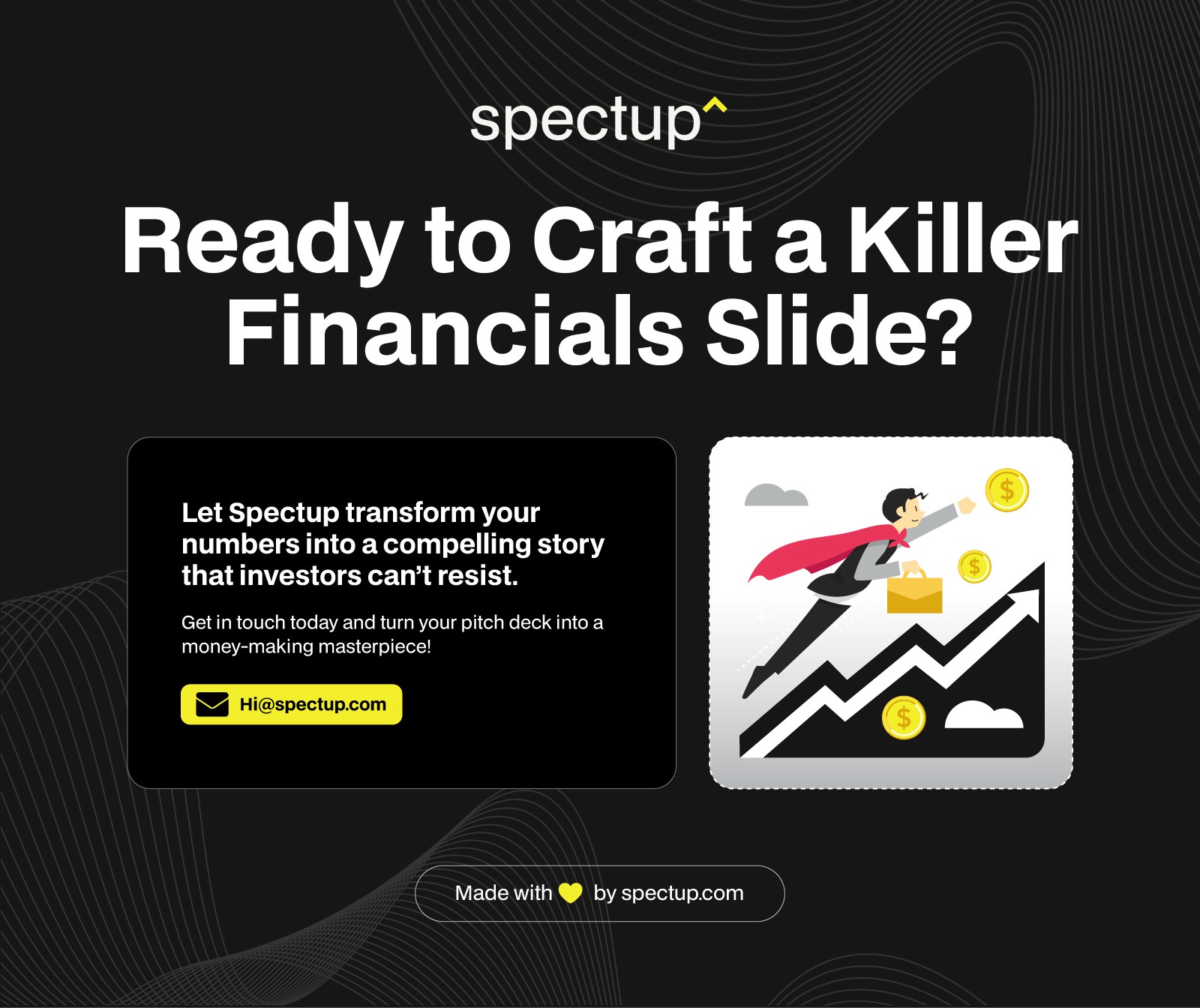
Ever tried telling your company's story without numbers? It's like baking bread without yeast—it just falls flat. The Financials slide in your pitch deck is that crucial spot where your vision shakes hands with hard data. You've got to nail the balance between making it look slick and keeping the information crystal clear. That means showcasing not just your big ideas but also your solid grasp of income statements, revenue models, and overall financial health.
Remember, investors aren't just pouring money into ideas; they're investing in you. That's why transparency and financial literacy are more than just buzzwords—they're the bedrock of building trust. So when you're crafting that Financials slide, do it thoughtfully. Show where you stand today and where you're headed tomorrow. Maybe even sprinkle in some agile methods and sustainability practices to catch the eye of modern investors and consumers who care about more than just the bottom line.
Niclas Schlopsna
Partner
Ex-banker, drove scale at N26, launched new ventures at Deloitte, and built from scratch across three startup ecosystems.







